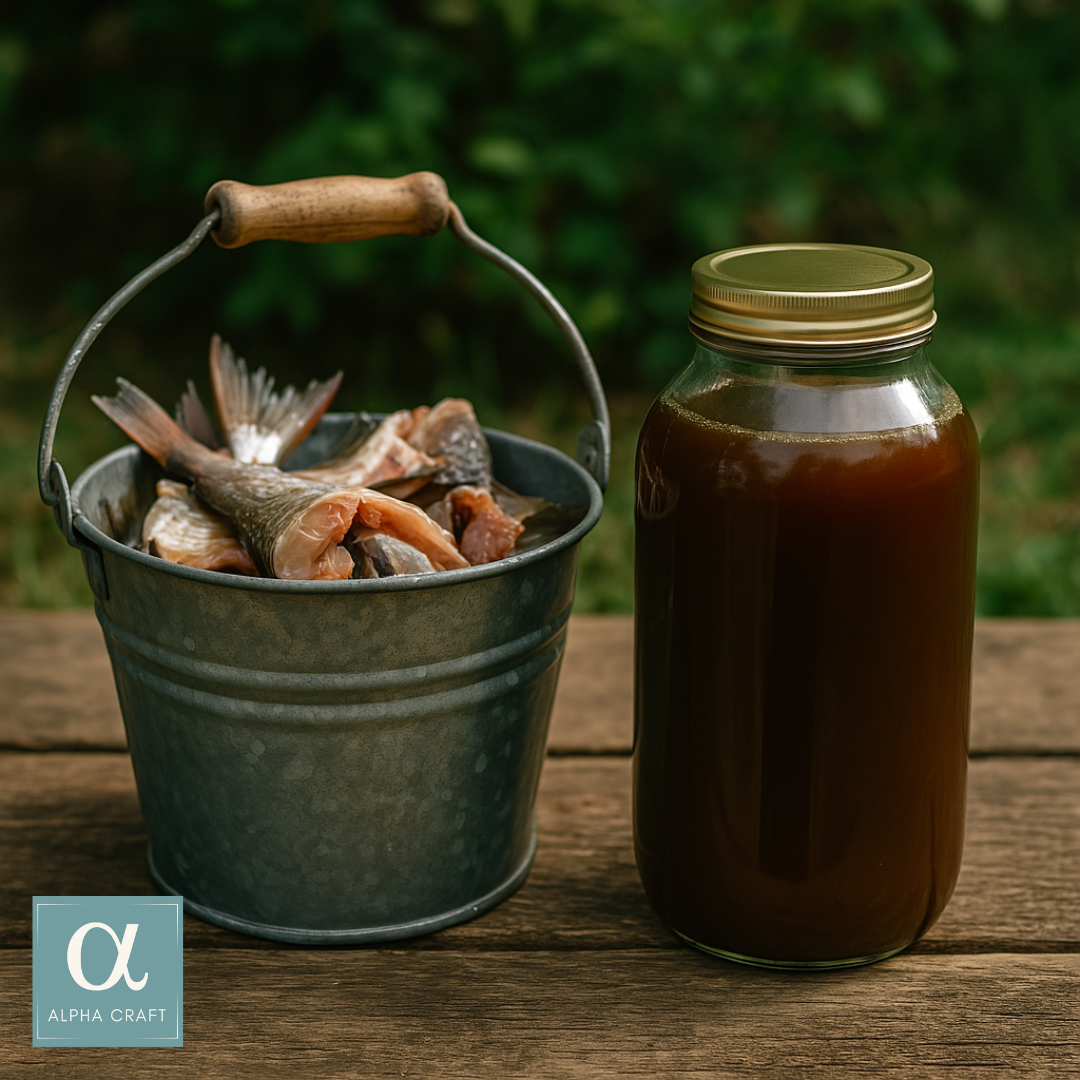Fish Emulsion Fertilizer
Make your own nutrient-rich fish emulsion to boost plant growth and soil health. Packed with nitrogen for lush foliage, phosphorus for strong roots, potassium for overall plant vitality, plus trace minerals and beneficial microbes. Perfect for vegetable gardens, flowers, and perennials!

Inventory
Some of the links in this post are affiliate links, and we may receive a commission if you purchase through them.
Tools & Equipment
- Two - 5-gallon buckets with lid
- Stirring Stick
- Mesh Cover or Cheesecloth
Ingredients
- 5 lbs, Leftover Fish Scraps: heads, guts, bones and other fish parts (keep stored in the freezer until you have a whole batch)
- Carbon-rich Browns (one of the following):
- 2 cups Leaf Mold or Dried Leaves
- 2 cups Straw or Hay
- 1-2 cups Shredded Newspaper or Cardboard
- 1-2 cups Coco Coir
- 1-2 cups Coffee Grounds
- 1 cups Wood Chips or Bark Mulch
- 1-2 cups, Brown Sugar or Molasses
- 4-5 gallons, Water
Instructions
Wear disposable gloves when handling raw fish and thoroughly wash your hands and surfaces when done; raw fish can carry pathogens like Salmonella, E. coli, and Vibrio.
Wear gloves, long sleeves, and a mask while handling during fermentation if odors are intense.
Prepare the Fish
If you can, chop larger pieces into manageable chunks
This will speed up fermentation
Mix Ingredients
Fill a 5-gallon bucket with 4 gallons of water. Add the fish scraps, the carbon-rich brown material, and molasses. Stir.
The brown materials will help balance the high nitrogen content of the fish and reduce the smell.
The molasses feeds beneficial bacteria.
Secure the bucket
Cover the bucket with wire mesh or cheesecloth. Place the lid on without sealing shut. Store the bucket in a shady, well-ventilated, warm area, away from living spaces. Place something heavy on top to ensure nothing gets in there.
The mesh covering is imperative to keeping pests out, both big and small. The decomposing material will attract many species, especially flies, which will use your fermenting fish as a breeding ground.
You want to be sure some air can escape out of the sides of the lid because there will be gases released during fermentation.
Ferment
Stir the mix every 2-3 days. Allow fermentation to continue for 4-8 weeks. It will be finished when most of the fish have decomposed into a slurry.
It's important to keep it aerated to prevent harmful bacteria from taking over. The mixture may have a stronger odor initially, but it will mellow over time as the microbes work. If the odor is unbearable, add more carbon-rich browns periodically.
Strain
Place cheesecloth or fine mesh over another 5-gallon bucket and strain the mixture. Compost or bury the remaining solids directly in the garden as slow-release fertilizer.
Application
To use fish emulsion, dilute 1 part emulsion to 10 parts water. Put the mixture in a spray bottle and apply it as a foliar spray for fast absorption, or pour it around the base of plants to enrich the soil.
Always dilute fish emulsion; otherwise, you can cause plant burn. Apply early morning or late evening to prevent leaf burn and reduce odor release.
Fish emulsion provides a quick boost of nitrogen along with trace minerals. Knowing the right time to apply it can maximize its benefits and help you avoid potential issues like nitrogen burn.
Signs of Nitrogen Deficiency | Yellowing leaves, slow growth, pale color, stunted plants after transplanting
Best Times to Use Fish Emulsion | Seed starting, Transplanting, Every 2-4 weeks during the active growing phase, As needed (based on signs of deficiency)
Storage: Store in a Mason jar or a glass jar with an airtight lid for 6-12 months in a cool, dark place. Shake before use. It should smell earthy and fishy. It has gone bad if it has a foul odor, mold growth, separation, or thick sludge at the bottom. If this happens, bury the liquid in the soil to discard it.
Modifications
Blend Fish for Faster Breakdown
Before mixing the ingredients, place your fish scraps in a blender or food processor to create smaller pieces. The greater surface area exposed will speed up fermentation.
Long-Term Storage
If you know you'll be storing for a while, add 1/2 cup per 5 gallons of emulsion after straining. This will help preserve the finished product by lowering the pH and creating an environment where spoilage bacteria and fungi cannot thrive.
Boost Microbial Activity
Introduce beneficial microbes to accelerate fermentation and improve nutrient breakdown.
EM-1 or Lactic Acid Bacteria (LAB) Serum | 1 cup per 5 gallons
For faster and cleaner fermentation
Molasses or Cane Sugar | 1-2 cups per 5 gallon
For better quality of the emulsion
Balance the pH
Fish emulsion is often too acidic, which many plants may not agree with. If this is the case, combine your fish emulsion application with an application of limestone or eggshell fertilizer
Fungal Dominant
Perennial beds, trees, and shrubs prefer higher levels of fungi. At the start of fermentation, simply add 1 cup oat flour or ground oats to the mix.
Every craft begins as an alpha craft. Crafts are developed by considering the function and effect of inputs and all the actions needed to create the transformation. They are designed with theory and research but have not been personally tested by any Guild Craft Trade employee or member. When you perform a craft at this stage, it is through your own experimentation (and risk, if there is any).
This designation is part of our mission to build a chain of production for cottage industry. To learn more, see our About page.